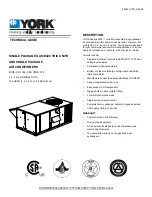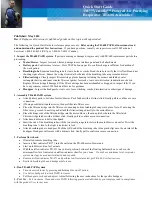
Page 15
IMPORTANT
Sprinklers and soaker hoses should not be installed
where they could cause prolonged exposure to the
outdoor unit by treated water. Prolonged exposure
of the unit to treated water (i.e., sprinkler systems,
soakers, waste water, etc.) will corrode the surface of
the steel and aluminum parts, diminish performance
and affect longevity of the unit.
Thermostat Operation
See the thermostat homeowner manual for instructions on
how to operate your thermostat.
Pre-Service Check
If your system fails to operate, check the following before
calling for service:
• Verify room thermostat settings are correct.
• Verify that all electrical disconnect switches are ON.
• Check for any blown fuses or tripped circuit breakers.
• Verify unit access panels are in place.
•
Verify air filter is clean.
If service is needed, locate and write down the unit model
number and have it handy before calling.
Professional Maintenance
Your heating and air conditioning system should be in-
spected and maintained twice each year (before the start
of the cooling and heating seasons) by a licensed profes-
sional HVAC technician. You can expect the technician to
check the following items.
These checks may only be
conducted by a licensed professional HVAC techni-
cian
.
Outdoor Unit
1 -
Inspect component wiring for loose, worn or
damaged connections. Also check for any rubbing
or pinching of wires. Confirm proper voltage plus
amperage of outdoor unit.
2 - Check the cleanliness of outdoor fan and blade
condition (cracks) and clean or replace them, if
necessary.
3 - Inspect base pan drains for debris and clean as
necessary.
4 -
Inspect the condition of refrigerant piping and
confirm that pipes are not rubbing copper-to-
copper. Also, check the condition of the insulation
on the refrigerant lines. Repair, correct, or replace
as necessary.
5 - Test capacitor. Replace as necessary.
6 -
Inspect contactor contacts for pitting or burn marks.
Replace as necessary.
7 -
Check outdoor fan motor for worn bearings/
bushings. Replace as necessary.
8 - Inspect and clean outdoor coils, if necessary and
note any damage to coils or signs of leakage.
Indoor Unit (Air Handler or Furnace)
1 -
Inspect component wiring for loose, worn or
damaged connections. Confirm proper voltage plus
amperage of indoor unit.
2 -
Inspect and clean or replace air filters in indoor unit.
3 - Check the cleanliness of indoor blower and clean
blower, if necessary.
4 - Inspect the indoor coil drain pans and condensate
drains for rust, debris, obstructions, leaks or cracks.
Pour water in pans to confirm proper drainage from
the pan through to the outlet of the pipe. Clean or
replace as necessary.
5 - Inspect and clean indoor coil, if necessary.
6 -
Inspect the condition of the refrigerant lines and
confirm that pipes are not rubbing copper-to-
copper. Also, ensure that refrigerant pipes are not
being affected by indoor air contamination. Check
condition of insulation on the refrigerant lines.
Repair, correct, or replace as necessary.
7 - Inspect the duct system for leaks or other problems.
Repair or replace as necessary.
8 - Check for bearing/bushing wear on indoor blower
motor. Replace as necessary.
9 -
If your unit is matched with a gas- or oil-fired furnace,
indoor unit service will also include inspection and
cleaning of the burners, and a full inspection of
the gas valve, heat exchanger and flue (exhaust)
system.
General System Test with System Operating
1 - Your technician should perform a general system
test. He will turn on the air conditioner to check
operating functions such as the startup and shutoff
operation. He will also check for unusual noises or
odors, and measure indoor/outdoor temperatures
and system pressures as needed. He will check
the refrigerant charge per the charging sticker
information on the outdoor unit.
2 -
Verify that system total static pressure and airflow
settings are within specific operating parameters.
3 - Verify correct temperature drop across indoor coil.


































